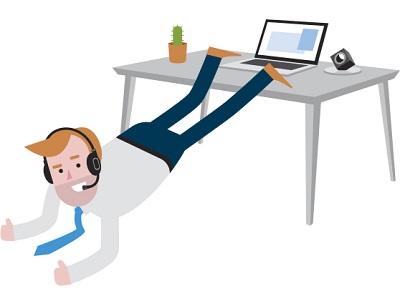There were 1 posts tagged: Sitting
Is Excessive Sitting the New Health Epidemic?

It’s a scientific fact that leading a sedentary lifestyle can be harmful to one’s health.
The job category of “knowledge worker” – people who handle information as their job – can be considered sedentary, where employees remain seated and desk-bound for 8 or more hours each day. This does not include their commute time to the job … which could be an hour or more each way. Your job (and the time it takes to get there) just may be harming you!
What are the harmful effects of inactivity?
According to an article on the Australian government health department web site, some hazards associated with sitting all day include:
- Weakened legs and gluteals, which could lead to falls, and strains when exercising
- Weight gain
- Hips and back – hip flexor muscles shortened, leading to problems in hip joints; sitting for extended periods of time can cause problems in your back, especially if you have poor posture
- Anxiety and depression
- Cancer, heart disease, diabetes
- Varicose veins, Deep vein thrombosis
- Stiff neck and shoulders
The current official U.S.-government issued Physical Activity Guidelines, in place since 2008, says that adults (classified as ages 18-64) who are physically active are less likely to develop chronic diseases than adults who aren’t active – regardless of gender or ethnicity. The Office of Disease Prevention and Health Promotion reports that the worst thing to do is to avoid activity – any physical activity is better than none, and has health benefits.
Aerobic activity is best for substantial health benefits. Each week, strive for at least 150 minutes (2 hours, 30 minutes) of moderate-intensity aerobic physical activity (brisk walking, ballroom dancing, doubles tennis, water aerobics); or, 75 minutes (1 hour, 15 minutes) of vigorous-intensity aerobic physical activity (jogging, singles tennis, jumping rope, aerobic dancing or swimming laps); or a combination of these activities. Doing more than these recommended amounts each week leads to even greater health benefits.
At least twice a week, muscle-strengthening activities that are moderate or high intensity and involve all major muscle groups should be completed. This is defined as lifting weights or using resistance bands. Why is strength training recommended? It protects bone health and muscle mass, makes you stronger and fitter, keeps weight off for good, burns more calories, and helps with balance, coordination and posture — to name a few of the benefits.
New government guidelines are expected to be published by the end of 2018.
Of course, these activities will happen either before or after work; however, it is still possible to incorporate physical activity into even the most sedentary of desk jobs.
 Tips to Keep Your Office in Shape:
Tips to Keep Your Office in Shape:* Take the stairs instead of the elevator
* Walk over and talk to co-workers, rather than sending an email
* Exercise on your lunch break
* Organize “walking meetings”
* Use a wireless headset and walk around the office while on calls
* Park your car in a far away spot to get extra steps to the building; or, ride your bike or walk to work.
Enjoy this quick Sennheiser video about how to get your office in shape (we particularly like the chair lifts!)
Get moving on your job today – even if you are one of the approximately 86 percent of the U.S. workers who sit all day – be creative and find ways to incorporate movement in your daily routine.
Sources:
Victoria State Government Better Health Channel: The dangers of sitting: why sitting is the new smoking
ODPHP: Guidelines for Adult Activity
U.S. News and World Report: Are you suffering from sitting disease?
Everyday Health: 7 Ways Strength Training Boosts Your Health and Fitness

